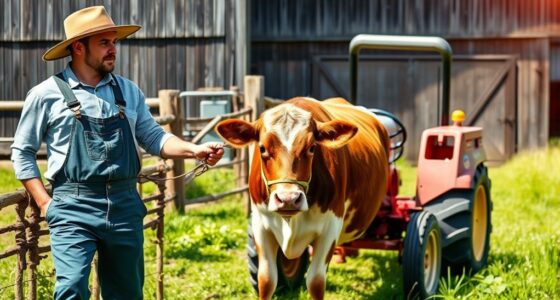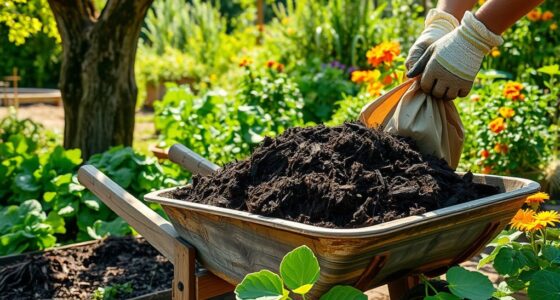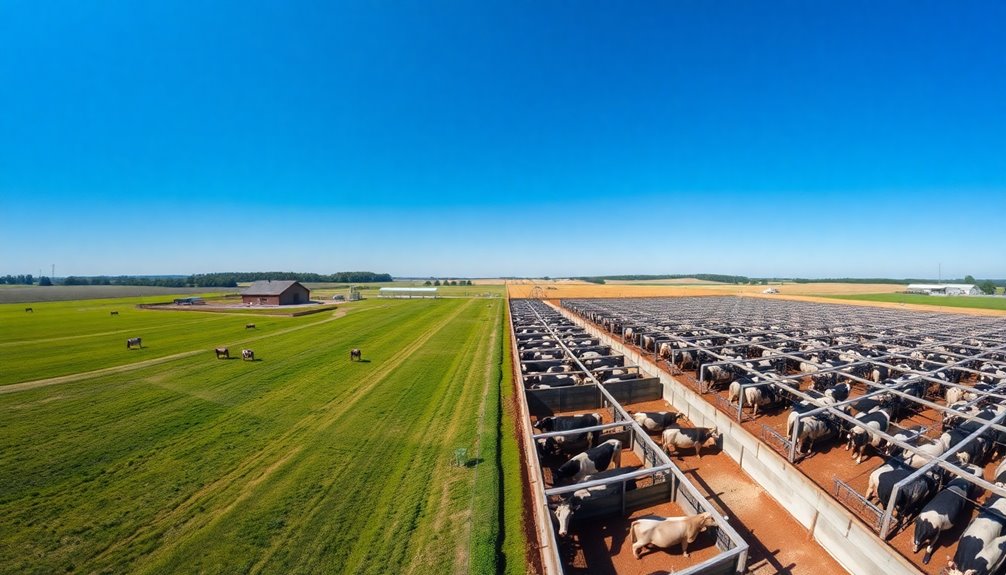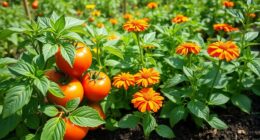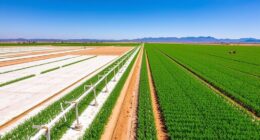To keep bees for pollination and honey, create a supportive environment by placing hives away from traffic and bright lights, and keeping your apiary clean. Monitor bee health with regular inspections, checking for pests like Varroa mites. Minimize pesticide exposure by timing applications to avoid blooming plants. Supplement feeding when food is scarce, and guarantee a diverse range of forage is available. Setting up your apiary correctly lays the foundation for successful beekeeping; there's so much more to discover!
Key Takeaways
- Choose a quiet, clean location for your hives, away from bright lights and heavy traffic to reduce bee stress and increase productivity.
- Conduct regular inspections every 7-10 days to monitor bee health, checking for pests like Varroa mites and signs of diseases.
- Minimize pesticide exposure by avoiding applications on blooming plants and coordinating with local growers to protect pollinators during peak foraging times.
- Provide supplemental feeding with sugar syrup and protein supplements during food scarcity to support bee health and enhance honey production.
- Ensure diverse forage availability by managing flowering plants throughout the season, promoting effective pollination and overall colony health.
The Importance of a Supportive Environment for Bees
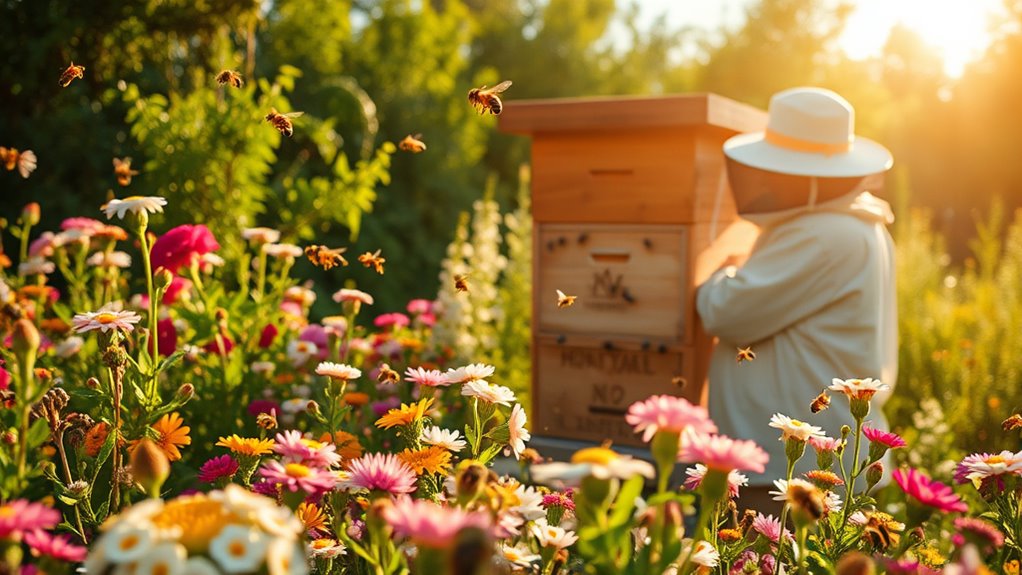
Creating a supportive environment for bees is vital for their health and productivity, especially since they rely on a diverse range of flowering plants for food.
Proper hive placement is important; locate your hives in quiet areas away from bright lights and heavy traffic to reduce stress on your bees. Keeping the apiary clean prevents pests and creates a healthier habitat for your colonies.
Additionally, eliminating competing weeds through mowing or herbicides guarantees that bees focus on desired crops during foraging, boosting pollination efficiency.
Engaging with local beekeeping clubs can provide you with valuable insights and resources, as seasoned beekeepers share best practices for creating a thriving environment for your bees and guaranteeing successful beekeeping.
Monitoring Bee Health and Disease Management
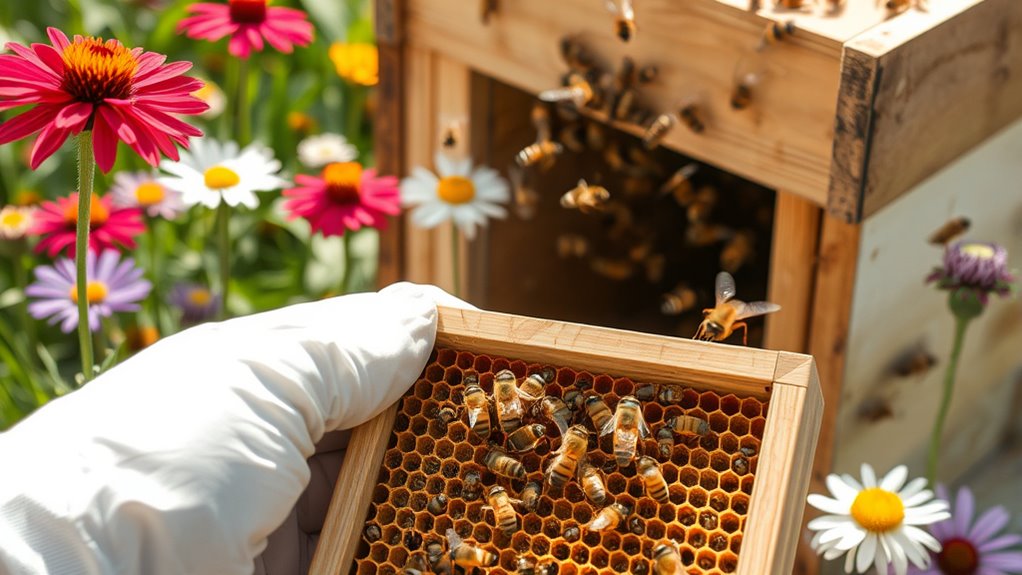
To keep your bees healthy, you need to conduct regular hive inspections.
This helps you spot any pests or diseases early on, allowing you to take action before they become a serious issue.
Regular Hive Inspections
Regular hive inspections are essential for maintaining a thriving bee colony, as they allow you to monitor bee health, spot diseases, and evaluate the colony's strength. Conduct these inspections every 7-10 days during the active season to catch issues early.
Check for Varroa mites, as these pests can weaken your bees and lead to higher mortality rates if not managed swiftly. Inspect the brood pattern; a healthy queen will produce a consistent pattern, indicating good reproductive health.
Additionally, look for signs of diseases like American foulbrood or chalkbrood, which can spread quickly and devastate your hive.
Pest and Disease Control
While keeping bees can be a rewarding endeavor, effectively managing pests and diseases is essential for maintaining the health of your colony.
Regularly monitor for varroa mites, as they pose a significant threat to your bees. Implement Integrated Pest Management strategies that combine chemical and non-chemical methods to control pests while minimizing harm to your hive.
Conduct periodic health assessments to catch signs of disease, such as American foulbrood or chalkbrood, and act quickly to treat any outbreaks.
Maintain a clean apiary by removing dead bees and debris, which helps reduce disease spread.
Finally, use screened bottom boards and entrance reducers to monitor pest levels and improve ventilation, ultimately enhancing your hives' overall health.
Minimizing Pesticide Exposure for Pollinators
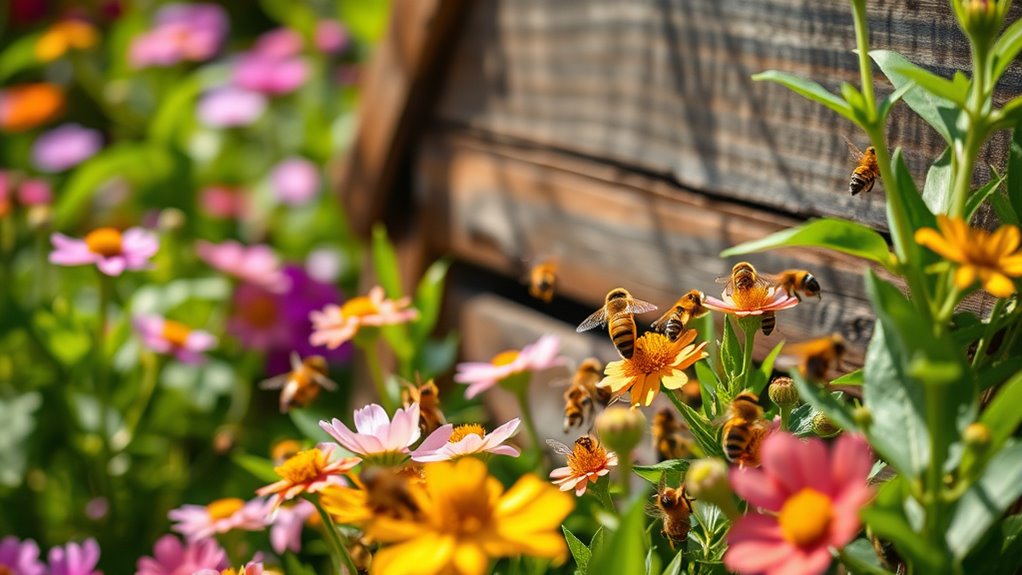
Minimizing pesticide exposure for pollinators is essential for maintaining healthy bee populations and ensuring effective pollination. Most bee poisonings happen when foraging bees visit treated flowers, rather than from direct spraying of hives.
To protect these important pollinators, avoid applying insecticides on blooming plants, especially during peak foraging times. Fast-acting insecticides can kill bees immediately, while slow-acting toxins contaminate hive food, harming young bees and threatening colony health.
Clear communication between growers and beekeepers is critical to coordinate pesticide applications and reduce exposure risks.
Supplemental Feeding and Forage Management
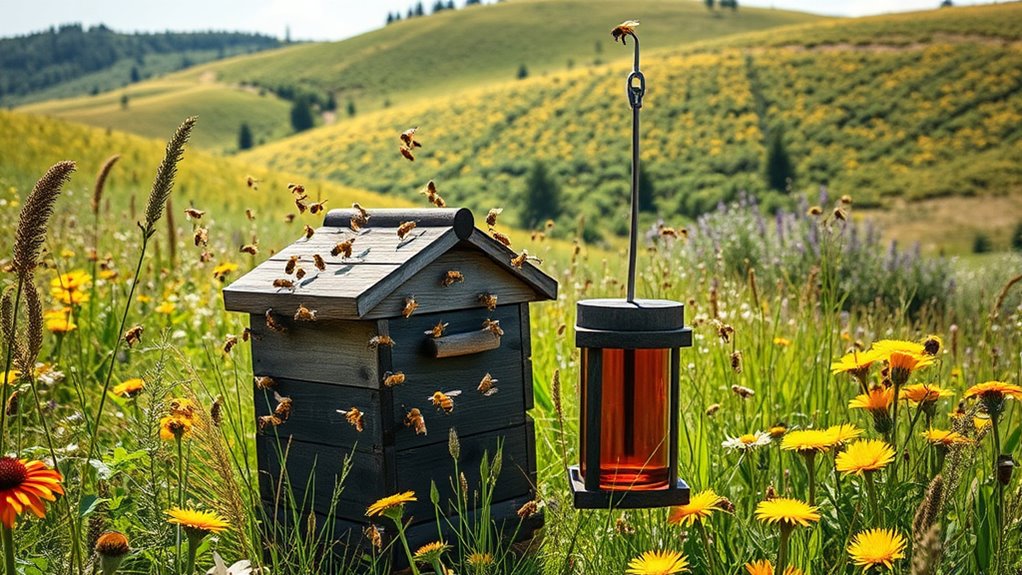
When you're managing your bee colonies, supplemental feeding can be essential during times when natural food sources are scarce.
By providing sugar syrup and protein supplements, you'll support their health and boost brood production.
Additionally, effective forage management guarantees that bees have access to diverse flowering plants throughout the season, keeping them well-fed and thriving.
Importance of Supplemental Feeding
Supplemental feeding plays an essential role in maintaining the health and productivity of honey bee colonies, particularly during times when natural forage is limited.
When nectar is scarce, providing supplemental feeding guarantees your bees receive the necessary carbohydrates and proteins to thrive. Common options like sugar syrup and pollen patties can help stimulate brood production, allowing your colonies to grow and increase their foraging capacity.
By monitoring bee activity and local forage availability, you can determine the best timing and type of feed needed. Additionally, combining supplemental feeding with healthy foraging practices—such as planting diverse flowering plants—can further enhance your bees' nutrition and overall pollination efficiency.
This holistic approach keeps your colonies strong and productive.
Managing Forage Availability
Maintaining a healthy bee colony involves more than just supplemental feeding; managing forage availability is equally important. Bees thrive on a diverse diet rich in proteins and carbohydrates, essential for their immune system and overall well-being.
To guarantee adequate forage availability, monitor local flowering plants and position your hives near abundant food sources. This boosts foraging efficiency and enhances pollination outcomes.
During times of nectar flow shortages, consider supplemental feeding with sugar syrup or protein patties, especially in early spring and late fall.
Also, maintain a variety of flowering plants throughout the growing season to sustain bee populations. Practices like mowing to control weeds and planting cover crops can greatly improve available forage, supporting effective bee management.
Setting Up Your Apiary for Success

To guarantee your apiary thrives, start by carefully evaluating your yard's layout for ideal hive placement. Ascertain your hives are at least 10 feet away from property lines, elevated above foot traffic, and have a clear flight path. Aim to set up two hives initially, which allows for better management and comparison of colony health.
| Hive Placement | Local Regulations | Natural Barriers |
|---|---|---|
| 10 feet from lines | Check local laws | Use fences/hedges |
| Clear flight path | Max three colonies | Quiet area |
| Elevated placement | Safety for all | Floral resources |
Building Community Relationships as a Beekeeper
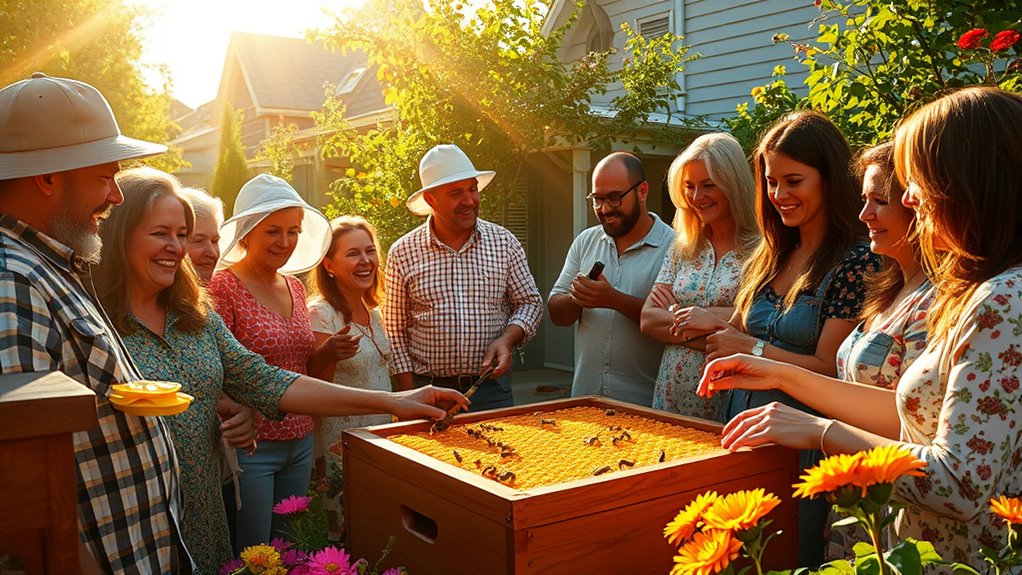
As you commence your beekeeping journey, fostering strong relationships with your neighbors can greatly enhance community support for your efforts. Open communication about honey bee behavior helps alleviate fears and builds goodwill.
Here are some ways to strengthen those ties:
- Share honey from your hives as a sweet gesture.
- Educate neighbors on how bees travel up to 3 miles for foraging.
- Provide your contact information, encouraging them to ask questions.
- Join local beekeeping clubs to connect with experienced beekeepers.
Essential Equipment for Beekeeping
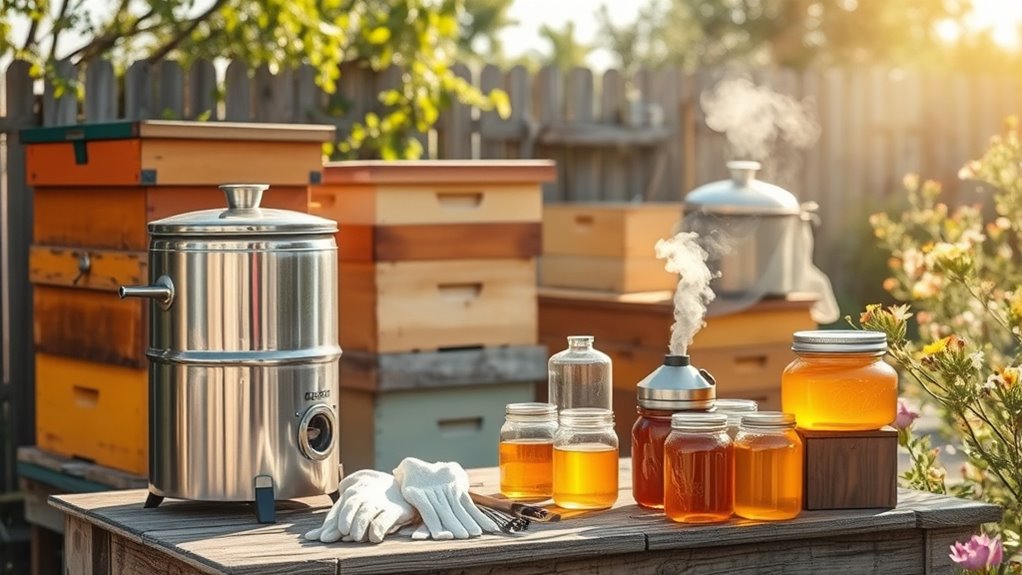
Building strong community relationships creates a supportive environment for your beekeeping efforts, but to succeed, you'll need the right tools at your disposal.
Building community connections fosters a nurturing atmosphere for your beekeeping journey, essential for achieving success.
Start with a Langstroth hive, the most common type in the U.S., which consists of stacked boxes called supers for housing your bee colony and storing honey.
A bee suit, complete with gloves and a veil, is essential for protecting yourself from stings during inspections.
Don't forget a smoker; it calms the bees and masks alarm pheromones, reducing defensive behavior.
You'll also need hive tools, like scrapers and frame lifters, to manage your hives effectively.
Finally, use feeders—either internal or entrance types—to provide sugar syrup, especially when nectar is scarce or when establishing new colonies.
Frequently Asked Questions
How to Keep Bees for Honey?
To keep bees for honey, you'll want to start by choosing a suitable hive, like a Langstroth.
Place it near flowering plants to guarantee your bees have plenty of nectar.
Regularly inspect the hive to check its health and manage pests.
During late summer, harvest the honey when the supers are capped.
Use proper extraction techniques to maximize yield while keeping the comb intact for your bees.
Enjoy the sweet rewards of your hard work!
What Is the 7/10 Rule for Beekeeping?
So, you think you can just toss some bees in a box and call it a day? Think again!
The 7/10 Rule for beekeeping says you need at least 70% of your hives thriving to make honey or pollinate effectively. This means strong colonies with enough brood to keep those little workers buzzing.
Monitor their health, place hives wisely, and you'll see the sweet rewards of both honey and fruitful crops!
How Many Bees Do You Need for a Tax Write-Off?
To qualify for tax write-offs in beekeeping, you typically need at least two hives. This shows the IRS that you're serious about your beekeeping activities.
You'll want to keep detailed records of your income and expenses related to honey production and hive maintenance.
Don't forget to document costs for equipment and supplies.
Consulting a tax professional can help you navigate the rules and maximize your deductions effectively.
What Is the 3 Feet 3 Mile Rule for Bees?
Imagine a bustling city where people and bees coexist. The "3 feet" rule is like a gentle sidewalk, keeping bees away from your path, ensuring you stroll without worry.
Meanwhile, the "3 mile" rule is their adventurous spirit, allowing them to explore vast fields for nectar.
Conclusion
By nurturing a supportive environment and prioritizing bee health, you're not just keeping bees; you're cultivating a thriving ecosystem. The sweet rewards of honey and abundant pollination will flow like a river, enriching your garden and community. Remember, every effort you make—whether reducing pesticide use or building relationships—creates a ripple effect that benefits both your bees and the world around you. Embrace your role as a beekeeper, and let nature's harmony flourish!



